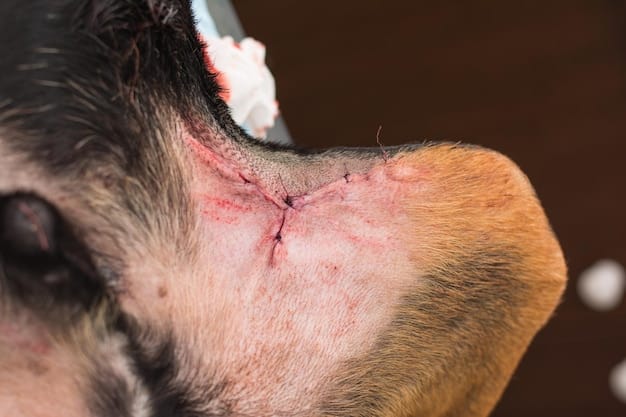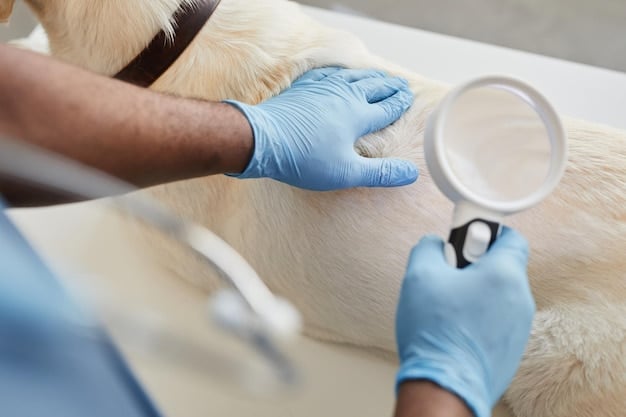Stop the Scratch: Identifying & Treating Pet Skin Problems

Anúncios
Excessive itching in pets can indicate underlying skin conditions such as allergies, infections, or parasites, necessitating veterinary diagnosis and treatment for relief.
Is your furry friend constantly scratching, licking, or rubbing against furniture? Is Your Pet Itching Excessively? Identifying and Treating Common Skin Conditions is crucial for their health and well-being. Let’s dive into the potential causes and what you can do to provide them relief.
Anúncios
Understanding Why Your Pet Is Itching
Itching, medically known as pruritus, is a common symptom in pets that can stem from various underlying issues. Recognizing the potential causes is the first step toward providing effective relief and ensuring your pet’s comfort.
Understanding the reasons behind your pet’s itching habits can pave the way for appropriate treatment plans. Let’s explore the common culprits behind this irritating issue.
Anúncios
Common Causes of Itching
Itching in pets can be caused by a variety of factors, ranging from external parasites to allergic reactions. Below are some of the primary reasons why your pet might be scratching excessively:
- Fleas: These tiny parasites are a frequent cause of itching in both cats and dogs. They feed on blood and can cause intense irritation.
- Allergies: Pets can be allergic to food ingredients, environmental elements like pollen, or even substances they come into contact with.
- Skin Infections: Bacterial or yeast infections can lead to inflammation and itching. These infections often occur secondary to other skin issues.
- Mites: Microscopic mites like mange mites can burrow into the skin, causing severe itching and hair loss.

Identifying the specific cause is important, as each requires different treatment approaches. Consulting a veterinarian for a thorough examination is critical in determining the root cause and creating an effective treatment plan.
Recognizing the Signs of Skin Conditions
Identifying the signs of skin conditions early can help prevent them from escalating and causing more discomfort to your pet. Knowing what to look for enables prompt intervention and treatment.
Recognizing the early signs of skin conditions is crucial in ensuring your pet’s well-being and comfort. Vigilance and regular check-ups can go a long way in managing these conditions effectively.
Key Symptoms to Watch For
Several signs can indicate that your pet is suffering from a skin condition. Here are some of the most common symptoms to be aware of:
- Excessive Scratching: Persistent and intense scratching is often the first sign of a skin problem.
- Hair Loss: Bald patches or thinning fur can indicate underlying skin issues.
- Redness and Inflammation: Inflamed or red skin suggests irritation, infection, or allergic reaction.
- Skin Lesions: Sores, scabs, or pustules can be signs of infection or other dermatological issues.
Regularly examining your pet’s skin can help you detect these signs early. If you notice any of these symptoms, it’s important to seek veterinary advice.
The Role of Allergies in Pet Skin Problems
Allergies play a significant role in many skin conditions seen in pets. Understanding these allergies and how they affect your pet’s skin is crucial for effective management.
Allergies can manifest in various ways, affecting not only the skin but also the overall health of your pet. Identifying and managing these allergies is key to improving their quality of life.
Allergies in pets can generally be categorized into three main types:
- Food allergies
- Environmental allergies
- Flea allergies
Each type of allergy can present with different symptoms and require specific management strategies.
Managing Food Allergies
Food allergies occur when a pet’s immune system reacts to certain ingredients in their food. Common allergens include beef, chicken, dairy, and wheat. To manage food allergies, consider the following steps:
- Elimination Diet: Work with your veterinarian to implement an elimination diet. This involves feeding your pet a novel protein and carbohydrate source for several weeks to see if symptoms improve.
- Hypoallergenic Diets: Choose commercially available hypoallergenic diets that contain hydrolyzed proteins or limited ingredients to reduce the risk of allergic reactions.
Careful dietary management can significantly reduce the symptoms of food allergies and improve your pet’s skin health.
Dealing with Infections: Bacterial and Fungal
Skin infections, whether bacterial or fungal, can cause significant discomfort and itching in pets. Understanding how to identify and treat these infections is essential for maintaining your pet’s skin health.

Bacterial and fungal infections often occur as secondary problems due to weakened skin barriers or underlying health issues. Prompt and appropriate treatment can prevent these infections from becoming chronic.
Once you suspect an infection, it is time to seek immediate veterinary care. Diagnosing bacterial and Fungal Infections involves several steps:
- Physical Examination
- Skin Scrapings
- Fungal Culture
The Impact of Parasites on Skin Health
External parasites like fleas and mites are common culprits behind skin problems in pets. Understanding how these parasites affect the skin and how to control them is essential for preventing and treating infestations.
Parasitic infestations can cause intense itching, inflammation, and secondary infections. Effective parasite control is a crucial part of maintaining your pet’s skin health.
Effective Flea Control Measures
Fleas are a common cause of itching and skin irritation in pets. Effective flea control involves a multi-faceted approach:
- Topical Treatments: Use veterinarian-approved topical flea treatments regularly.
- Oral Medications: Consider oral flea medications that provide systemic protection.
- Environmental Control: Treat your home and yard to eliminate fleas in all life stages.
Consistent flea control helps prevent infestations and reduces the risk of flea-related skin problems.
Treatment Options and Home Care Tips
Treating skin conditions in pets often involves a combination of veterinary care and home care strategies. Following your veterinarian’s recommendations and implementing good home care practices can significantly improve your pet’s comfort and skin health.
Effective treatment requires a holistic approach, addressing both the symptoms and the underlying causes. Supportive home care plays a critical role in the recovery process.
Veterinary Treatments for Skin Conditions
Veterinary treatments may include:
- Prescription Medications
- Specialized Shampoos
- Allergy Management Strategies
Work closely with your veterinarian to develop a treatment plan tailored to your pet’s specific needs.
Here are some home care tips:
- Bathing and Grooming
- Proper Nutrition
- Environmental Management
| Key Point | Brief Description |
|---|---|
| 🔍 Identifying Causes | Fleas, allergies, and infections are common causes of excessive itching. |
| 🚨 Recognizing Signs | Watch for scratching, hair loss, redness, and skin lesions. |
| 💊 Treatment Options | Include medication, special shampoos, and allergy management. |
| 🏡 Home Care | Bathing, grooming, proper nutrition, and environmental management are key. |
Frequently Asked Questions
▼
Common causes of itching in pets include flea infestations, allergies (food or environmental), and skin infections (bacterial or fungal). Mites can also cause intense itching.
▼
Signs of food allergies include chronic itching, skin inflammation, ear infections, and digestive issues. An elimination diet can help determine if your pet has a food allergy.
▼
Oatmeal baths, hypoallergenic shampoos, and proper hydration can help soothe itchy skin. Always consult with your veterinarian before trying new remedies.
▼
Regular grooming is essential. It helps remove allergens, parasites, and dead skin, promoting better skin health. Use grooming tools appropriate for your pet’s coat type.
▼
If itching is severe, persistent, or accompanied by hair loss, redness, or skin lesions, consult your vet. Early diagnosis and treatment can prevent complications.
Conclusion
Dealing with your pet’s excessive itching can be challenging, but with the right knowledge and approach, you can significantly improve their comfort and quality of life. Remember to consult with your veterinarian for accurate diagnosis and treatment plans, and implement supportive home care strategies to keep your furry friend happy and healthy.






